Molar mass 297.83 g/mol Formula WF6 Melting point 2.3 °C | Density 4.56 g/cm³ Boiling point 17.1 °C Appearance Colorless gas | |
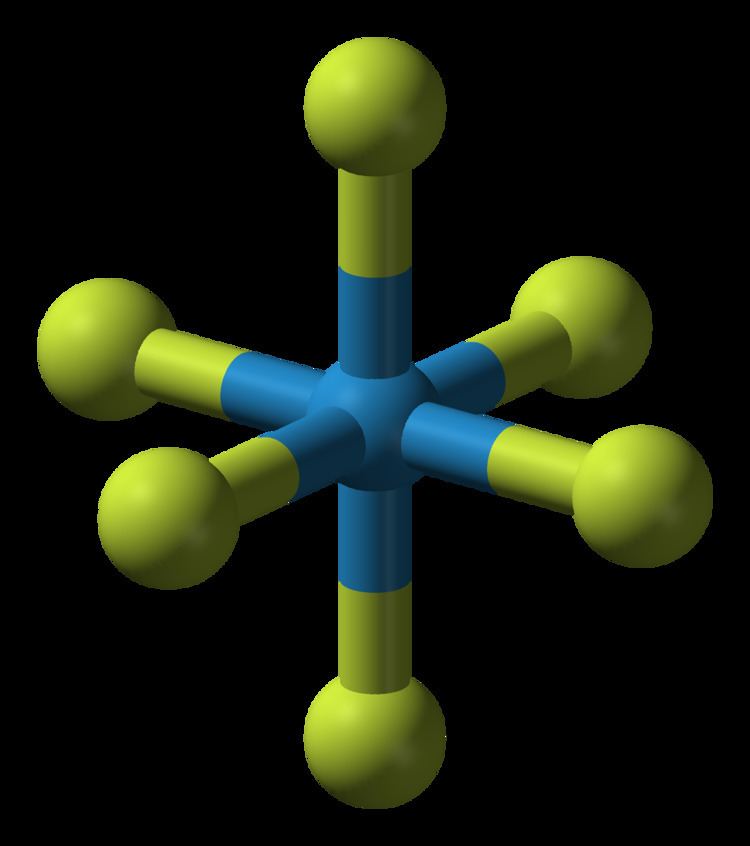 | ||
Related compounds | ||
Tungsten(VI) fluoride, also known as tungsten hexafluoride, is the inorganic compound of tungsten and fluorine with the formula WF6. This corrosive, colorless compound is a gas under standard conditions, with a density of about 13 g/L (roughly 11 times heavier than air.), WF6 is one of the heaviest known gases under standard conditions. WF6 gas is most commonly used in the production of semiconductor circuits and circuit boards through the process of chemical vapor deposition – upon decomposition, molecules of WF6 leave a residue of metallic tungsten. This layer serves as low-resistive metallic "interconnect".
Contents
- Properties
- Synthesis
- Reactions
- Applications in semiconductor industry
- Silicon
- Hydrogen
- Silane and germane
- Other applications
- Safety
- Related compounds
- References
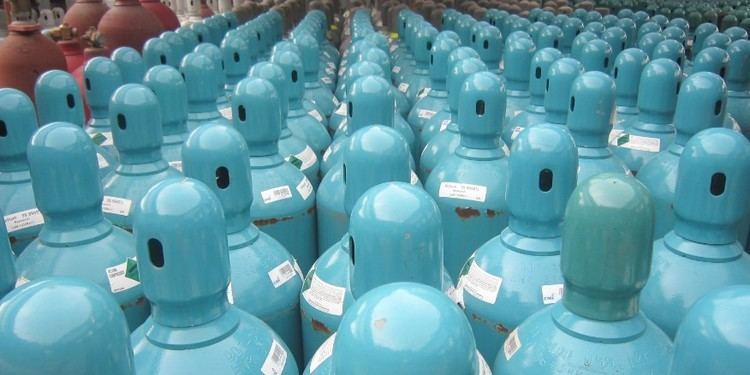
Properties
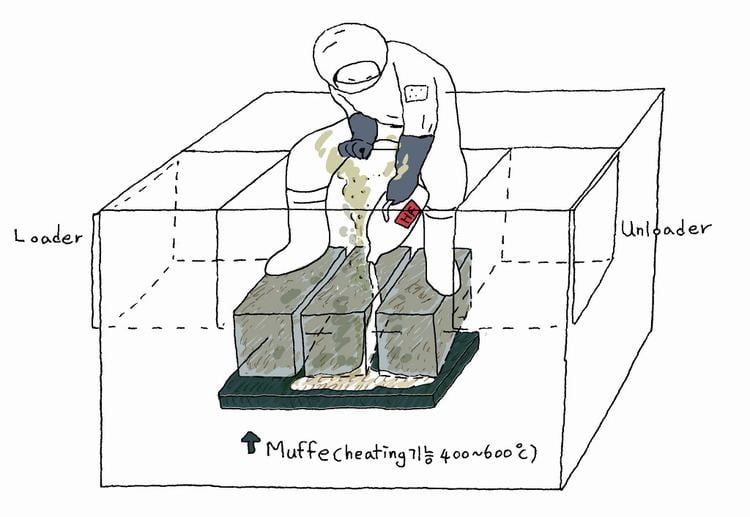
At ambient pressure and temperatures above 17 °C, tungsten hexafluoride is a colorless diamagnetic gas. The WF6 molecule is octahedral with the symmetry point group of Oh. The W–F bond distances are 183.2 pm. Between 2.3 and 17 °C, tungsten hexafluoride condenses into a pale yellow liquid having the density of 3.44 g/cm3 at 15 °C. At 2.3 °C it freezes into a white solid having a cubic crystalline structure, the lattice constant of 628 pm and calculated density 3.99 g/cm3. At −9 °C this structure transforms into an orthorhombic solid with the lattice constants of a = 960.3 pm, b = 871.3 pm, and c = 504.4 pm, and the density of 4.56 g/cm3. In this phase, the W–F distance is 181 pm, and the mean closest intermolecular contacts are 312 pm. Whereas WF6 gas is one of the heaviest gases, with the density exceeding that of the heaviest elemental gas radon (9.73 g/L), the density of WF6 in the liquid and solid state is rather moderate. The vapor pressure of WF6 between −70 °C and 17 °C can be described by the equation
log10 P = 4.55569 − (1021.208 / (T + 208.45)),where the P = vapor pressure (bar), T = temperature (°C).
Synthesis

Tungsten hexafluoride is commonly produced by the exothermic reaction of fluorine gas with tungsten powder at a temperature between 350 and 400 °C:
W + 3 F2 → WF6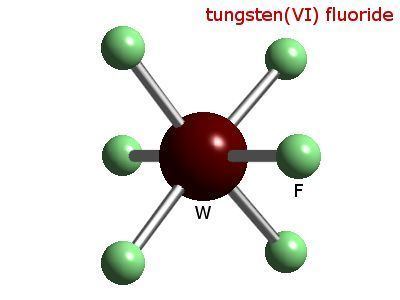
The gaseous product is condensed and separated by distillation from WOF4, a common impurity. In a variation on the direct fluorination, the metal is placed in a heated reactor, slightly pressurized to 1.2 to 2.0 psi (8.3 to 13.8 kPa), with a constant flow of WF6 infused with a small amount of fluorine gas.
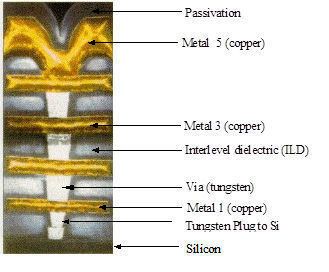
The fluorine gas in the above method can be substituted by ClF, ClF3 or BrF3. An alternative procedure for producing tungsten fluoride is to react tungsten trioxide (WO3) with HF, BrF3 or SF4. Tungsten fluoride can also be obtained by conversion of tungsten hexachloride:
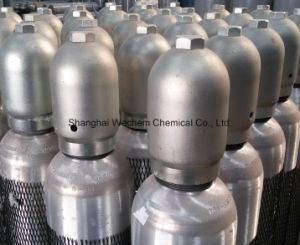
Reactions
On contact with water, tungsten hexafluoride gives hydrogen fluoride (HF) and tungsten oxyfluorides, eventually forming tungsten trioxide:
WF6 + 3 H2O → WO3 + 6 HF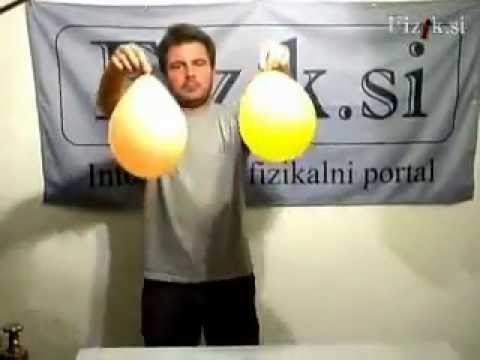
Unlike some other metal fluorides, WF6 is not a useful fluorinating agent nor is it a powerful oxidant. It can be reduced to the yellow WF4.
Applications in semiconductor industry
The dominant application of tungsten fluoride is in semiconductor industry, where it is widely used for depositing tungsten metal in a chemical vapor deposition process. The expansion of the industry in the 1980s and 1990s resulted in the increase of WF6 consumption, which remains at around 200 tonnes per year worldwide. Tungsten metal is attractive because of its relatively high thermal and chemical stability, as well as low resistivity (5.6 µΩ·cm) and electromigration. Whereas WF6 is favored over related compounds, such as WCl6 or WBr6, because of its higher vapor pressure resulting in higher deposition rates. Since 1967, two WF6 deposition routes have been developed and employed, thermal decomposition and hydrogen reduction. The required WF6 gas purity is rather high and varies between 99.98% and 99.9995% depending on the application.
WF6 molecules have to be split up in the CVD process. The decomposition is usually facilitated by mixing WF6 with hydrogen, silane, germane, diborane, phosphine, and related hydrogen-containing gases.
Silicon
WF6 reacts upon contact with a silicon substrate. The WF6 decomposition on silicon is temperature-dependent:
2 WF6 + 3 Si → 2 W + 3 SiF4 below 400 °C andWF6 + 3 Si → W + 3 SiF2 above 400 °C.This dependence is crucial, as twice as much silicon is being consumed at higher temperatures. The deposition occurs selectively on pure Si only, but not on silicon oxide or nitride, thus the reaction is highly sensitive to contamination or substrate pre-treatment. The decomposition reaction is fast, but saturates when the tungsten layer thickness reaches 10–15 micrometers. The saturation occurs because the tungsten layer stops diffusion of WF6 molecules to the Si substrate which is the only catalyst of molecular decomposition in this process.
If the deposition occurs not in an inert but in an oxygen containing atmosphere (air) then instead of tungsten, a tungsten oxide layer is produced.
Hydrogen
The deposition process occurs at temperatures between 300 and 800 °C and results in formation of hydrofluoric acid vapors:
WF6 + 3 H2 → W + 6 HFThe crystallinity of the produced tungsten layers can be controlled by altering the WF6/H2 ratio and the substrate temperature: low ratios and temperatures result in (100) oriented tungsten crystallites whereas higher values favor the (111) orientation. Formation of HF is a drawback, as the HF vapor is very aggressive and etches away most materials. Also, the deposited tungsten shows poor adhesion to the silicon dioxide which the main passivation material in semiconductor electronics. Therefore, SiO2 has to be covered with an extra buffer layer prior to the tungsten deposition. On the other hand, etching by HF may be beneficial to remove unwanted impurity layers.
Silane and germane
The characteristic features of tungsten deposition from the WF6/SiH4 are high speed, good adhesion and layer smoothness. The drawbacks are explosion hazard and high sensitivity of the deposition rate and morphology to the process parameters, such as mixing ratio, substrate temperature, etc. Therefore, silane is commonly used to create a thin tungsten nucleation layer. It is then switched to hydrogen, that slows down the deposition and cleans up the layer.
Deposition from WF6/GeH4 mixture is similar to that of WF6/SiH4, but the tungsten layer becomes contaminated with relatively (compared to Si) heavy germanium up to concentrations of 10–15%. This increases tungsten resistance from about 5 to 200 µΩ·cm.
Other applications
WF6 can be used for the production of tungsten carbide.
As a heavy gas, WF6 can be used as a buffer to control gas reactions. For example, it slows down the chemistry of the Ar/O2/H2 flame and reduces the flame temperature.
Safety
Tungsten hexafluoride is an extremely corrosive compound that attacks any tissue. Exposure of humans to the gas first affects the eyes and respiratory tracts causing irritation, loss of vision, cough, and excessive formation of saliva and sputum. Upon mixing with the body fluids, the gas transforms into hydrofluoric acid which burns the skin and mucous tissues of the respiratory tract. Upon prolonged exposure, this results in pneumonitis and pulmonary edema, and could be fatal. Because of the formation of hydrofluoric acid upon reaction of WF6 with humidity, WF6 storage vessels have Teflon gaskets.
Related compounds
Most related compounds share the octahedral symmetry of the WF6 molecule. However, hexamethyltungsten (W(CH3)6) and tungsten hexahydride (WH6) adopt a trigonal prismatic structure. Numerous hexafluorides are known with other metals and metalloids. Such MF6 compounds characteristically form dense gases, however, when element M is heavier than tungsten, the compound is either liquid or solid at room temperature.
